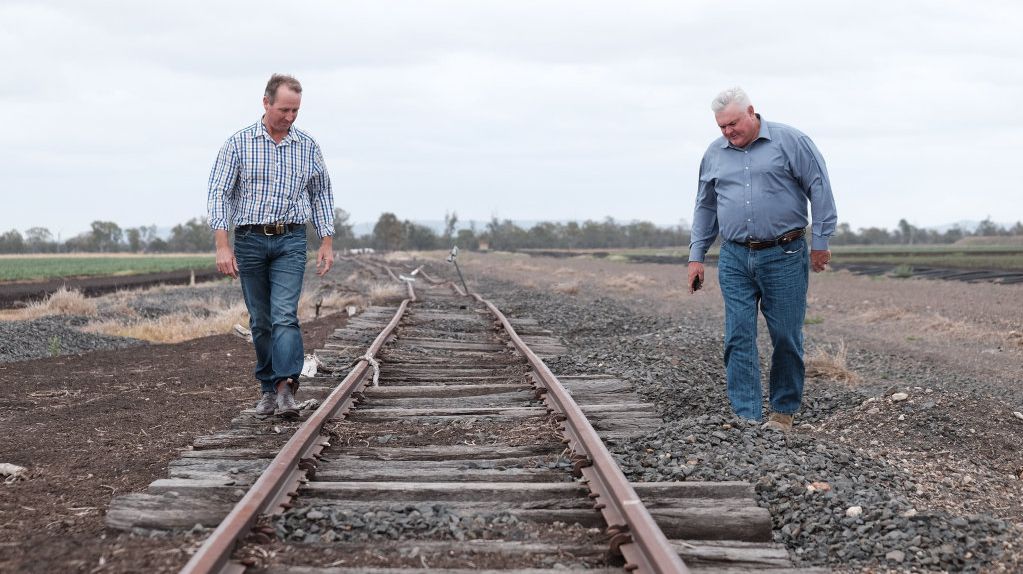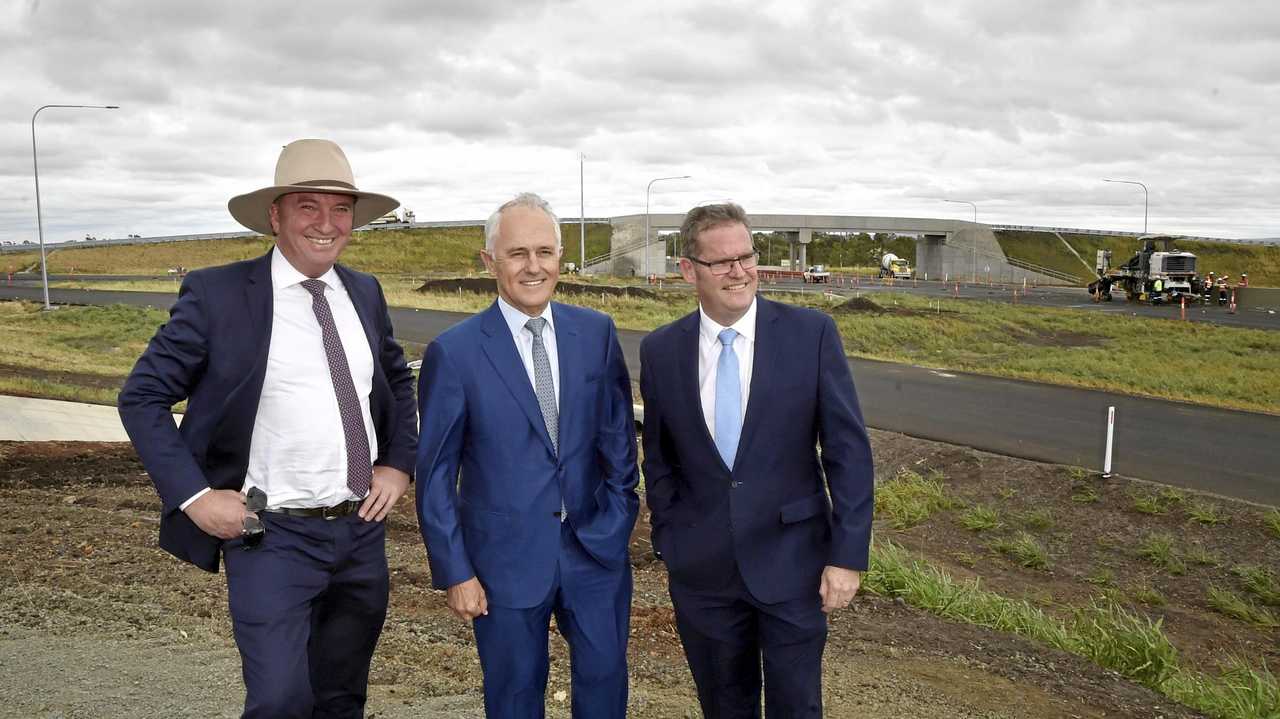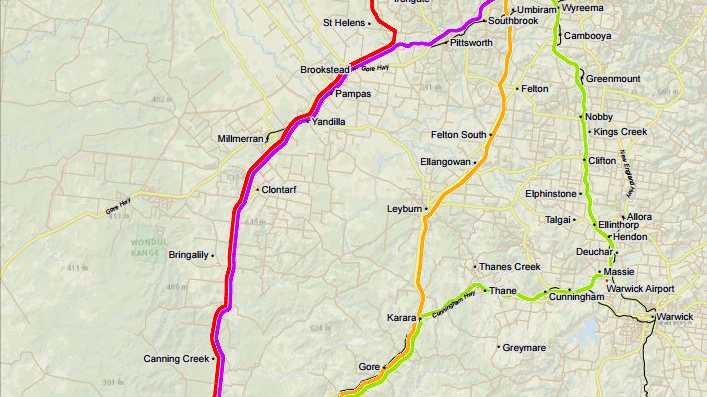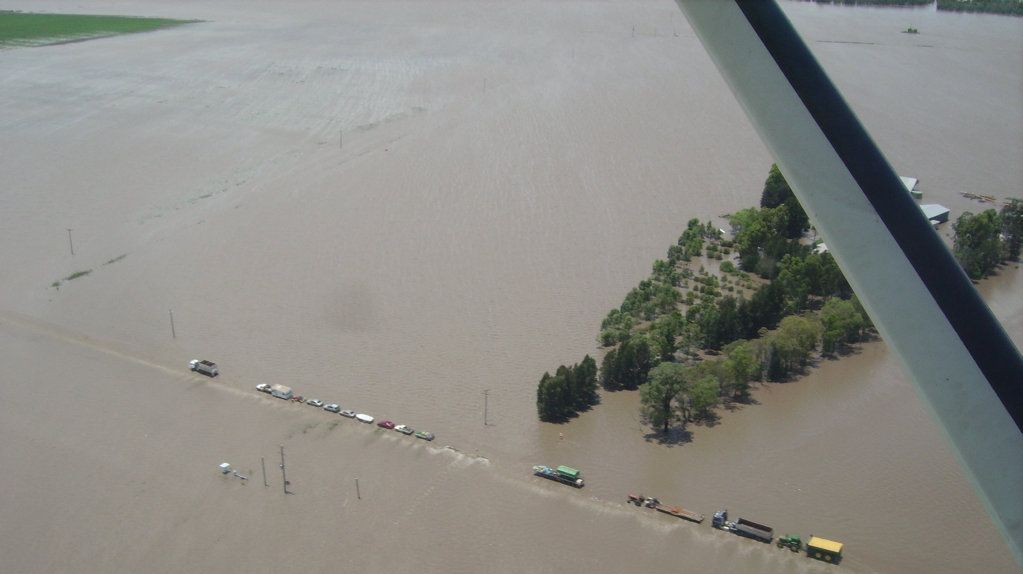LONG READ: Inland Rail hopes rest on Barnaby Joyce
HOPE. It’s the one thing landholders up and down the length of the government’s preferred Inland Rail route are clinging to as they move into 2018.

News
Don't miss out on the headlines from News. Followed categories will be added to My News.
HOPE.
It's the one thing landholders up and down the length of the government's preferred Inland Rail route are clinging to as they move into 2018, and it comes in the unlikely form of former Agriculture, now Federal Infrastructure and Transport Minister Barnaby Joyce.
But if Mr Joyce's rhetoric in Toowoomba on Thursday was anything to go by those hopes have been dashed somewhat.
The Chronicle has spoken to dozens of farmers and business owners along the Yelarbon to Gowrie route, which was announced in September last year.
At the top of their list of issues is the route's dissection of prime agricultural land, and the 12.5km crossing of the Condamine Floodplain, which they say could lead to the creation of an inland dam if it is not engineered properly.
They hope Mr Joyce, in his new role heading up the Infrastructure Portfolio and consequently the Inland Rail project, will finally listen to their concerns.
"He's got a rural background and he's got common sense so we'd be banking on that giving us some headway," Millmerran farmer Wes Judd said.
"We would hope he would be a minister more in charge of his ministry, and we'd be hoping he can review the whole process that's gone on to date."

Others, like Millmerran farmer Russell Stevens, are less optimistic the preferred route - which runs from Millmerran, across the black soil floodplain to Pampas, Brookstead, Pittsworth, Southbrook, and on into Wellcamp Airport - will change with Minister Joyce's appointment.
"It's just business as usual," he said.
"I hope I'm terribly wrong - but I don't think I'm going to be."
A separate group of farmers from the Inner Downs Inland Rail Action Group took matters into their own hands on Thursday, protesting out front of the Empire Theatre where Prime Minister Malcolm Turnbull and Mr Joyce gave a national address.
Minister Joyce said he was happy to meet with the landholders, but added: "I'll give you two arguments I get. Every town that it's not going through wants it to go through their town and stop there. And every piece of farmland it does go across, they want it but they want it on the place next door."
"No matter where we pick, I'm going to have people who are unhappy, but it's going to happen."

But the majority of people along the corridor are adamant the government's preferred route - the Charlton-Wellcamp route - is the wrong one.
Freedom of Information documents relating to Inland Rail obtained by the Inner Downs Inland Rail Action Group suggest that in the case of the Charlton-Wellcamp route, reaching the airport was an imperative that triumphed over land and farming impacts.
"An external driver that has not been driven by land and farming impacts has been the consideration of modifying the northern section of the alignment above Brookstead, such that it passes in close proximity to Charlton-Wellcamp Airport before re-joining the Base Case alignment near Gowrie," the document reads.
The two other routes assessed by the government - the Warwick and Karara-Leyburn routes - also would have linked to the airport.
Publicly, the government has painted its decision on the preferred Inland Rail route as one that balanced "community, economic, and environmental considerations".
Many believe economic considerations have triumphed over other concerns.
In March 2017, as the government was considering Yelarbon to Gowrie Inland rail routes, then Infrastructure Minister Darren Chester issued a press release stating the Wellcamp-Charlton option was the least expensive route modification, ahead of the Karara-Leyburn and Warwick options.

Six months later, it was the Wellcamp-Charlton option that was announced as the government's preferred route - described at the time as the "significantly more economically viable option than the alternative routes".
At Yandilla, 7km from Millmerran, sits DA Hall and Co, one of Australia's largest poultry farms.
The company is one of the largest employers in the area, with 270 staff, and the preferred route will go straight through the middle of some of their planned developments.
Owner Simon Hall said there needed to be more emphasis on the social and environmental impacts of the rail line.
"It's all been about the costings… They don't seem to be taking into account those social and environmental impacts," he said.
"And they need to because it's going to be there a bloody long time and disrupt a lot of people.
"All those things can largely be avoided if they choose an alternate route. So hopefully Barnaby can look objectively at all that sort of stuff."
As Wes Judd puts it, the community is not against Inland Rail, and agrees it "absolutely" needs to go via the airport.
"The problem is how they've tried to link the airport. Instead of taking the logical route to the (Wellcamp) airport, for whatever reason, they want to stay on this route," he said.
Mr Judd and other farmers agree the Karara-Leyburn route is the better option, crossing half the floodplain the Charlton-Wellcamp route does, with less dissection of prime agricultural land and property, and better terrain for track foundations.
The Karara-Leyburn route also scored marginally higher than the Charlton-Wellcamp route on the government's Corridor Options Report, which compared the three alternate routes on a "like for like" basis across a number of criteria.
Despite the government and ARTC's agreement that the Charlton-Wellcamp route was the cheapest of the three options, a grilling of ARTC and Department of Infrastructure officials by Senator Barry O'Sullivan in Senate Estimates last year revealed the cost of crossing 12.5km of the Condamine Floodplain was made on "high-level assumptions" and not on detailed engineering designs.
The revelation prompted Maranoa MP David Littleproud, along with eight other Nationals MPs to confront former Infrastructure Minister Darren Chester over his selection of the route, which led to Mr Chester announcing the expedition of flood and engineering studies to give certainty to the community. (Mr Chester was assigned to the Backbench in a Cabinet reshuffle in December.)
Paul Curtis, a sheep farmer near Millmerran, was blunt in his assessment of the project so far.
"If it was the best corridor, we'd be working with them to say, 'let's go here'," he said.
"We all know it's not, it's as simple as that. How can you say it's the cheapest route when they can't tell you what they're going to build?"
At the time, the government acknowledged an "engineered solution" would have to be devised to cross the Condamine Floodplain.
Yet after flood and engineering studies were expedited in October 2017, ARTC representatives in November were at community meetings talking about using pipes and culverts and a two-metre high gravel embankment to cross the floodplain, Mr Judd said.
Mr Judd believed the government's choice would eventually be more expensive once detailed costings and plans emerge.
"I think they're having a real struggle to understand they've got 12.5km of water now that's freely running, other than about a 600mm average height of the rail and the highway," Mr Judd said.
"Other than that, there's very little in that 12.5km that impedes (the flow of water), other than debris.
"Well, the minute you rise that bank, that's like the kids at the kindergarten playing in the sandpit. They can dig a hole and tip a cup of water in it and figure out... that's a dam."
Driving south-west along the Gore Highway near Pampas one overcast day late in 2017, Yandilla farmer Jason Mundt was concerned about many aspects of the Charlton-Wellcamp route - but there was one at the forefront of his mind - flooding.

"Where we are here, it's like having a dessert bowl. We're going through the deepest section where the line is here," he explained.
"This is the corridor here. We're going through the deepest section you can possibly think about. You couldn't pick a worse route for trying to get yourself out of the flooding."
And flood it does.
Bureau of Meteorology data shows the major flood level near where the Charlton-Wellcamp route crosses the Condamine floodplain has been reached or exceeded 19 times since the mid-1930s.
Floods of that level are enough to cut the Gore Highway, and did serious damage to the existing rail line (pictured above) west of Brookstead in the 2010, 2011 and 2013 floods.
Floods also bring with them tonnes of debris. After the 2013 flood, Mr Mundt said he removed 1200 tonnes of sorghum stubble, logs and trees from a 1.7km section of his farm.

Throw in the vast expanse of deep vertisol soil that, while good for farming, isn't good for building things on, and Mr Mundt can't see how a large structure can be built without it shifting constantly.
He pointed to the huge cracks in the Gore Highway as evidence of the way the ground moves under the weight of road trains.
Over the past 18 months, farmers along the preferred route have put in hundreds of hours researching and building a case for an alternate Inland Rail line.
An ARTC spokeswoman said the company is focused on designing "the best possible Inland Rail through the Darling Downs and that means the community's input is critical in shaping our engineering, socio-economic and environmental work".
"While it is not unusual for railways to cross floodplains we appreciate people need confidence, that's why ARTC is prioritising work to identify the engineering solution, in consultation with landowners.
"Preliminary findings, that will take into account previous work, are expected in the middle of 2018.
"We currently have a 2km-wide study area and there's 18-months to two-years-worth of work to refine this to the final 45m-60m wide rail corridor. As we progress there will be more information for people around flood modelling, property, level crossings and also how communities can reap the significant employment and economic benefits that Inland Rail is going to bring to the region."
Mr Judd said he and his fellow farmers had plenty of other things to do, rather than fighting the government over Inland Rail.
"We've got plenty to do, and we don't need our business or our reputations tarnished with any of this, but at the same time we've got to put something on the table to get an outcome," he said.
"I don't mind doing anything for the community - we've done it all our lives. But the government's put this on the table, not us."
Mr Mundt said it was time the government and ARTC heeded their concerns.
"It's like everyone's done the work for it and there's a problem there but (they're) not taking any notice and that's what is really starting to get under people's skin.
"There is a major problem there and God help us whatever they do."
Originally published as LONG READ: Inland Rail hopes rest on Barnaby Joyce






